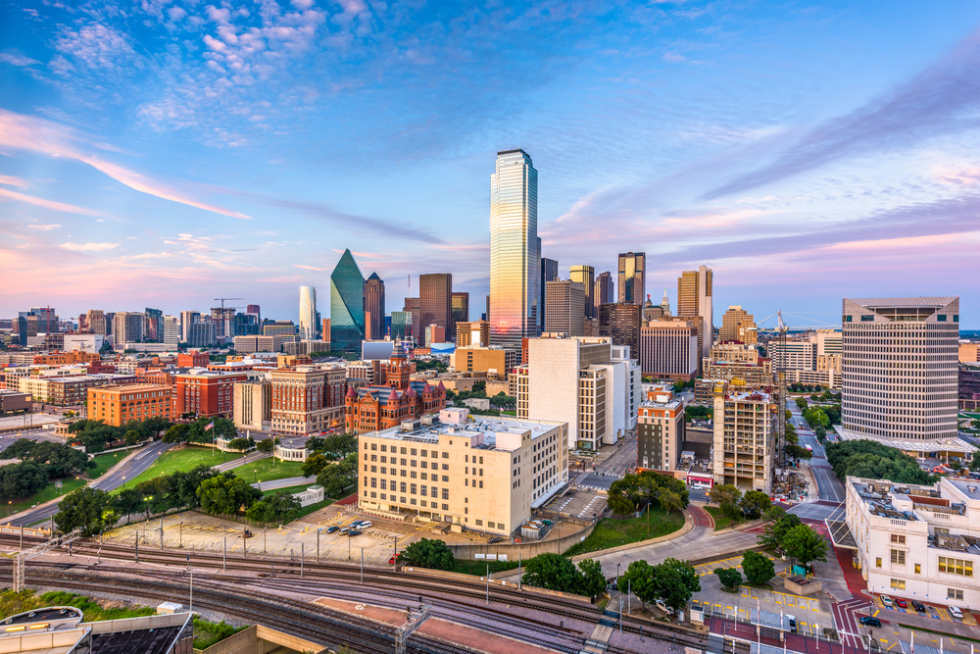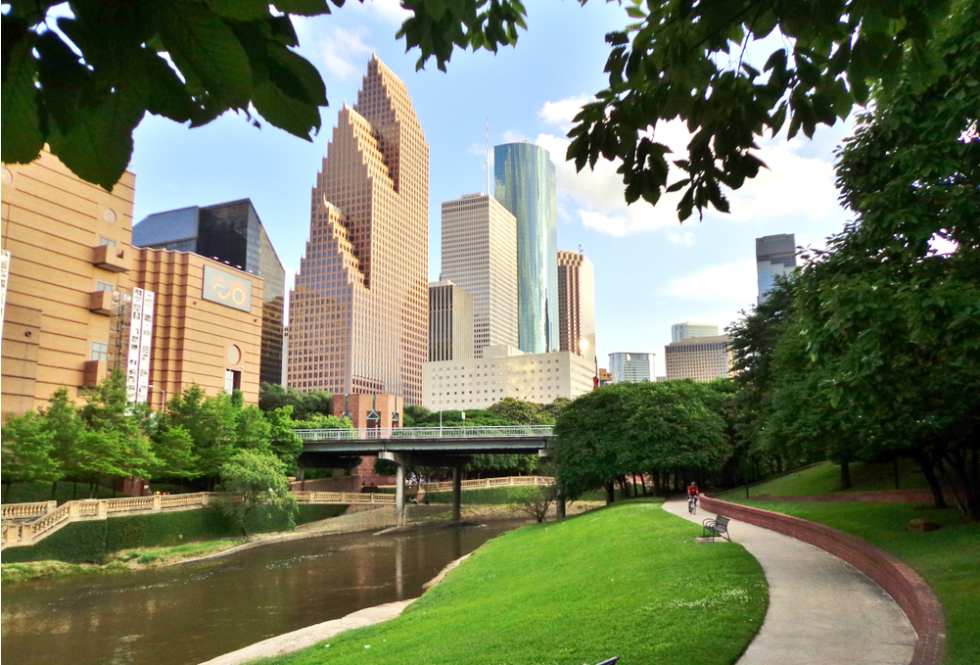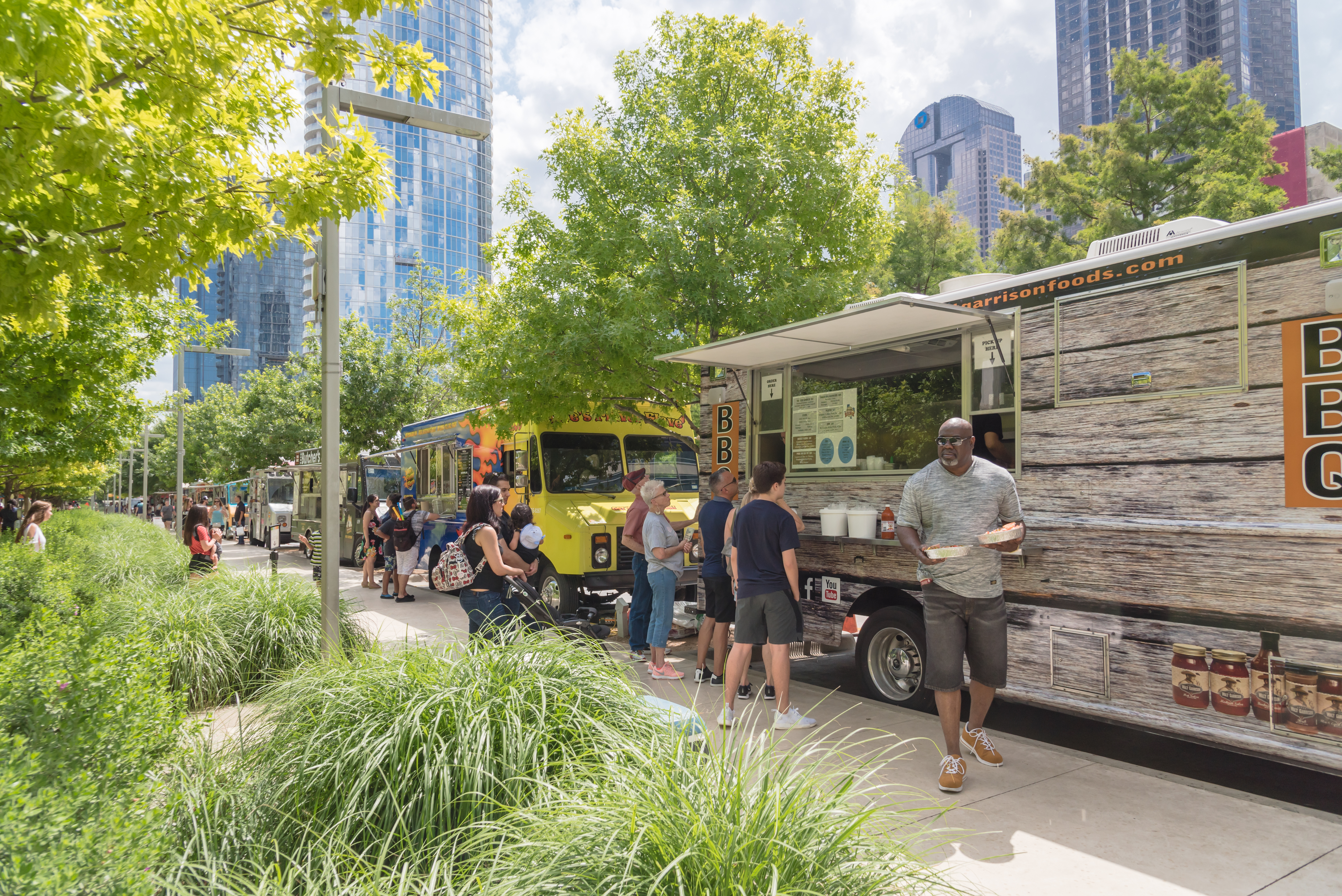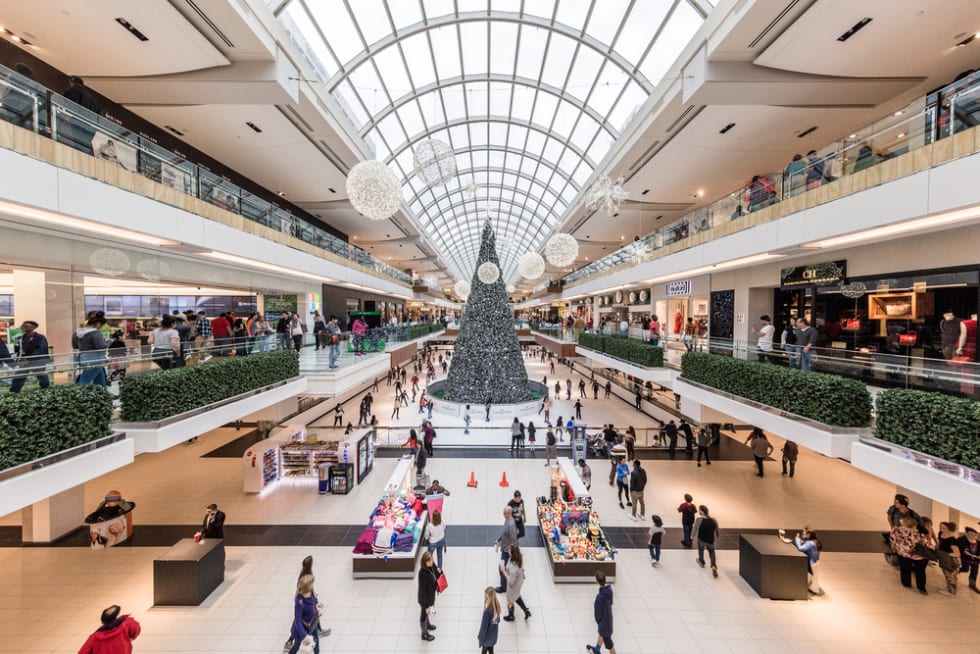Modera Trailhead
- 164 units available
- 1 bed • 2 bed • 3 bed
- Amenities
In unit laundry, Wine room, Patio / balcony, Granite counters, Dishwasher, Pet friendly + more

The Dallas vs. Houston debate is real, and the rivalry is as big as Texas. Both cities have booming economies, vibrant food scenes, and unique lifestyles that draw in renters from all over.
To help you figure out which city fits you best, we broke things down by vibe, budget, and career goals. We also connected with two locals—Dan Adkins in Dallas and Rebecca Banduh in Houston—for a first-hand look at what it’s really like to live in each city.
When comparing housing and rent in Dallas and Houston, it's important to gain a full understanding of the local market. We pulled the data for you so you can get a picture of both the average rental prices and median home costs.

Median Dallas home prices are below the national average and slightly below the state average. Of course, the Dallas metro neighborhood you live in also matters. A home in the affluent Highland Park will cost around $2,270,200, while a property in Mesquite is only $258,300.
We broke down what it really costs to live in Dallas—starting with the median home price.
| Area | Median Home Cost |
|---|---|
| National median home cost | $338,100 |
| State median home cost | $297,600 |
| Dallas median home cost | $295,100 |
If you’re looking to rent an apartment, you can get an idea of the median rent in Dallas with our latest rent report from spring 2025.
| Area | Dallas Median Home Cost |
|---|---|
| Overall | $1,347 |
| One bedroom | $1,231 |
| Two bedrooms | $1,457 |
Rents in Dallas nudged up slightly this spring, but they’re still lower than last year. Compared to the rest of Texas (and the country), Dallas is holding its own—making it a smart spot for renters looking for value without compromise.
Now let’s look at the median home cost in Houston and what you can expect.
| Area | Median Home Cost |
|---|---|
| National median home cost | $338,100 |
| State median home cost | $297,600 |
| Houston median home cost | $247,900 |
Like any other area you choose to live in, some areas of Houston will be pricier than others. Bellaire is among the wealthier areas in the Houston metro area, with a median home price of $923,500. Budget home hunters can look to Jacinto City to snag a home for $288,200.
We also reviewed our spring 2025 Houston rent report, which includes median rent prices.
| Bedrooms | Houston Median Rent Price |
|---|---|
| Overall | $1,298 |
| One bedroom | $1,145 |
| Two bedrooms | $1,358 |
Rents in Houston inched up last month, but they’re still lower than they were last year. Compared to the rest of Texas and the national average, Houston’s holding steady. For renters, that means more consistency and more value in a city that’s still affordable.

We also examined how different categories influence their unique Texas cost of living to help you determine which city is right for you.
Texas summers are known for being hot and humid, so be sure to allocate sufficient funds in your utility budget to find some relief from the triple-digit temperatures. In Dallas, the cost of basic electricity, heating, cooling, water, and garbage for a 915-square-foot apartment is $196.65 per month. Add on internet (60 Mbps or more, unlimited data, cable/ADSL) and a basic mobile phone plan, and that brings your total up to $376.36 per month.
In Houston, the costs are $221.18 for basic electricity, heating, cooling, water, and garbage and another $73.38 and $79.44 for a mobile phone plan and internet (60 Mbps or more, unlimited data, cable/ADSL), respectively, for a total of $327.15 per month.
Trying to get a handle on your cost of living in Dallas? Groceries alone can take a noticeable bite out of your budget. A single adult in Dallas can expect to spend around $4,021 a year on food. For a family of four with two working adults, that number rises to $11,786 annually.
In Houston, food costs are slightly easier on the wallet. A single adult spends about $3,853 a year, while the same-sized family spends around $11,294.
Overall, Texas doesn’t have a very robust public transportation system, but there are options in Dallas and Houston to choose from. Public transportation in Dallas, known as Dallas Area Rapid Transit (DART), starts at $3 for three hours of unlimited local service or $126 per month for deeper savings. Reduced fares are also available.
If you want to use public transportation in Houston, METRO local bus and rail fares are even cheaper. They start at $1.25 per ride and $40 per month for local access or $192 per month for regional access. Discounted fares are also available.
According to the living wage calculator, a single adult in Dallas spends around $10,208 a year on transportation, and a family of four with two working adults spends $17,123 annually. In Houston, a single adult will spend an average of $10,254 a year on transportation, while a family of two working adults and two children will spend an average of $17,200 annually.
Dallas and Houston offer two distinct takes on city living, each with its own advantages.
Dallas blends professional ambition with culture.
It’s a city known for its career-driven pace, but residents still make time for live music, sports, and weekend get-togethers. The urban core features sleek high-rises and upscale shopping, while surrounding neighborhoods offer quieter, family-friendly options. A growing arts scene and diverse local events add to the city’s appeal.
Outdoor recreation is also a key part of the lifestyle. As one local described it:
“We jump over to one of the local favorites, Sandy Pickles, the favorite place for pickleball; they have golf, pickleball, volleyball, a bar, food ... It's a great time on the weekend with your friends.” — Dan A.
Recreation spending in both Dallas and Houston is similar. A single adult typically budgets about $2,589 per year for activities like dining out, fitness, and local events. For a family of four with two working adults, that number increases to around $6,450 annually.
Houston offers space to grow and a strong sense of community.
As one of the most diverse cities in the U.S., Houston reflects its cultural richness through neighborhoods, cuisine, and community events. With over 56,000 acres of parks and trails, outdoor access is abundant. While traffic is a known challenge, the city’s vibrant arts scene, culinary reputation, and welcoming community make it a compelling place to live.
“Start your morning at Buffalo Bayou Park. It's one of the most peaceful spots in the city, with stunning skyline views. It somehow feels like a total escape from the hustle, even though you're still in the heart of Houston.” — Rebecca B.

Choosing between a larger and smaller city will significantly impact your lifestyle. Dallas and Houston both boast substantial populations, each offering unique advantages.
Dallas and Houston are renowned as two of the Lone Star State’s most influential cities, with an urban backdrop shaped by their growing size and population. According to data from the U.S. Census Bureau, Dallas is home to approximately 1,326,087 residents. The greater Dallas-Fort Worth-Arlington metro area includes about 8,100,037 people.
It may come as a surprise to newcomers that Houston is the more populous city, with approximately 2,390,125 residents. However, the overall Houston-Pasadena-The Woodlands metro area is smaller than Dallas’ greater region at about 7,510,252 people. Dallas is celebrated for its modern skyline and growing tech and business districts, but Houston’s broader city limits and denser population lend it a busier energy.
Both Dallas and Houston offer robust job markets, but they cater to different industries and opportunities.
If you’re moving to Dallas, you have your choice of career options. The city has emerged as a significant financial hub. AT&T, Texas Instruments, Comerica, CBRE, and Southwest Airlines are headquartered in Dallas, and in the greater Dallas-Fort Worth area, you’ll find several Fortune 500 companies, including Kimberly-Clark in nearby Irving, Texas.
Houston is also a growing epicenter of industry and is recognized as the Energy Capital of the World due to its significant presence in the oil and gas sector. It’s also celebrated for its aerospace industry. Energy companies, including ConocoPhillips, Phillips 66, Halliburton, and Chevron, are headquartered in Houston. Hewlett-Packard Enterprise, Sysco, and Enterprise Products are also headquartered here.
The median household income is $67,760 in Dallas and $62,894 in Houston, reflecting the strong job markets in both cities. Actual earnings will depend on your field, experience, and the specific opportunities available.
Safety should always be a paramount concern when choosing a place to live. The crime rate in Dallas is moderate at 51.24% but is on the rise. Fortunately, there are several neighborhoods in Dallas to choose from that are known for their safety.
Safest Neighborhoods in Dallas:
The crime rate in Houston is higher at 63.21%. Again, there are plenty of neighborhoods you can choose to live in that are considered safe and desirable places to live.
Safest Neighborhoods in Houston:
No matter where you choose to live, there are additional steps you can take to enhance your safety. Consider selecting an apartment complex in a well-lit area with secure parking and front desk staff, or inquire about installing a security system in your apartment.
Dallas and Houston each serve up bold, unforgettable flavors and vibrant cultural scenes—think world-class museums, dynamic music venues, and local food spots that fuel the cities’ friendly rivalry.
Dallas boasts a mouthwatering food scene featuring a blend of Tex-Mex, Texas barbecue, and global cuisine.
“One of the best things about Dallas is we have one of the best barbecues in the nation right down the street." — Dan A.
Here are some of the more popular restaurants with famous Dallas food:
Keep room in your budget for dining out in Dallas. You’ll spend between $75 and $90 for a three-course dinner for two or $20 for an inexpensive restaurant.
“One of my favorite things to do here on a chill Saturday [is heading off to the farmers market]. Just walk around for a few hours [and] grab some tacos and a delicious margarita. Hit up some local vendors, get yourself some raw honey, meat, fruit—you name it.” — Dan A.

Houston is also known for its flavorful Tex-Mex food, but it also has a unique Viet-Cajun fusion cuisine and specialties like crawfish, brisket, and iconic Houston fajitas.
“As the sun starts to set, head to Montrose for dinner. This neighborhood is filled with amazing restaurants, but one of my favorites is Rosie Cannonball. Think wood-fired pizza, handmade pasta, great cocktails, and even better vibes.” — Rebecca B.
Here are some of the more popular restaurants in Houston:
Dining prices in Houston are slightly lower than in Dallas. A three-course meal for two people at a moderate restaurant will cost $80, while an inexpensive restaurant will charge around $20.
“The Heights is Houston's most charming neighborhood. Head to Local Foods for brunch; you can't go wrong with anything on the menu, but my go-to is the Brunchy Chicken Sandwich. You'll thank me later.” — Rebecca B.
Dallas boasts the largest contiguous urban arts district in the U.S., featuring institutions like the Dallas Museum of Art, the Crow Museum of Asian Art, and the Nasher Sculpture Center. Music thrives in Deep Ellum, a historic neighborhood known for its jazz and blues heritage, now hosting various live performances. Annual events like the State Fair of Texas and the Dallas Arts Month also dot the calendar.
Houston's Museum District is home to renowned institutions like the Museum of Fine Arts, Houston; the Contemporary Arts Museum Houston; and the Houston Museum of Natural Science. The city's Theater District offers a robust lineup of performances, including those by the Houston Symphony and the Alley Theatre. Cultural festivals like the Houston Livestock Show and Rodeo and the Houston Art Car Parade showcase the city's eclectic spirit.
“For after-dinner drinks, walk over to Melrose, a chic, stylish bar with an Instagram-worthy interior and cozy outdoor patio—the perfect spot for a nightcap. If you're still not ready to call it a night, end your day at the iconic River Oaks Theatre. This historic art deco spot was recently renovated, and it is such a gem.” — Rebecca B.
If you’re concerned about education, both Dallas and Houston offer a wide range of education options, from public and private K–12 schools to renowned colleges and universities.
Dallas offers a diverse mix of educational opportunities, from highly rated public school districts to a range of private and charter schools. The city is also home to several respected colleges and universities, providing strong options for higher education.
Whether you're raising a family or pursuing a degree, Dallas offers education options to support every stage of learning.
Houston’s education landscape comprises a diverse array of public, private, and charter schools, as well as magnet programs and bilingual education options that reflect the city’s rich cultural diversity.
From early education to top-tier universities, Houston provides diverse academic pathways for students of all ages and backgrounds.
Commuting in Dallas and Houston presents distinct challenges shaped by each city's infrastructure and growth patterns. Here's a look at what to expect from some of the typical commute times in Houston vs. Dallas.
The average one-way commute in Dallas is approximately 26 minutes, with most residents driving alone to work. While traffic congestion can be significant during peak hours, the Dallas Area Rapid Transit (DART) system offers alternatives through its extensive light rail and bus networks.
The average one-way commute in Houston is about 27.3 minutes, making it one of the longer commute times in the country. Most residents drive, though METRO’s bus and light rail services offer alternatives for navigating the city’s busy roads.
If living near everything from world-class to budget-friendly shopping options is important to you, both Dallas and Houston offer options to suit your needs.
Dallas offers a dynamic shopping scene that blends luxury, local charm, and unique experiences across its top retail destinations:
“We got hit up some thrift and some local vendors here and there. Let’s jump into my favorite vintage and thrift shops. Thrifted Threads also gives away free ice cream, so grab a fit, grab some ice cream—it’s a great time.” — Dan A.
Don’t just stop at the main malls. Local favorites like the Dallas Farmers Market also offer handmade goods and unique finds you won’t find anywhere else.
Houston offers a vibrant and varied shopping experience, from designer labels to laid-back local gems:
Add local markets like the Heights Mercantile or GreenStreet Downtown to your must-shop list for even more variety.
“Stroll down 19th Street. This area is packed with local boutiques, vintage shops, record stores, and the cutest cafés. It's a total vibe.” — Rebecca B.

Choosing between Dallas and Houston comes down to what you value most, whether it’s career growth, lifestyle preferences, or affordability. Let’s look at the pros and cons of each to help make your decision easier.

Dallas offers a thriving job market, particularly in finance, tech, and business, along with a polished urban lifestyle and a growing arts scene. However, higher living costs and long commutes can be drawbacks for some residents. If you enjoy a fast-paced city with upscale amenities and diverse neighborhoods, Dallas could be the right fit.
If you’re moving to Houston, you’ll find it shines with its strong job market in energy, healthcare, and aerospace, along with a lower overall cost of living. The city’s diversity, cultural events, and food scene add to its appeal, though traffic congestion and a more sprawling layout can be challenging. For those prioritizing affordability and a rich cultural blend, Houston’s cost of living may be the better choice.
Whether you're drawn to Dallas’ professional polish or Houston’s vibrant diversity, both cities have a lot to offer. The choice between living in Dallas vs. Houston ultimately depends on your lifestyle and priorities.
Need an apartment for your move to Texas? Be sure to explore current rental listings for Dallas apartments and Houston apartments to see what meets your needs. Still undecided? Take the Apartment List quiz. With us, you’ll spend five minutes and save 50 hours searching.
Both cities have their perks. Houston stands out for its cultural diversity, global industries, and lower cost of living. Dallas offers a more polished city vibe, strong job growth in finance and tech, and a thriving arts scene. The better choice comes down to your priorities—career, budget, or lifestyle.
Houston added over 43,000 new residents in 2024, making it one of the fastest-growing cities in the country.
Houston's population is currently approximately 2,390,125 residents.
A single adult should earn approximately $91,770 annually to live in Dallas comfortably, covering housing, transportation, and other living expenses.
A single individual must earn about $75,088 a year to maintain a comfortable lifestyle in Houston without financial strain.
Dallas has become the most expensive city in Texas. If you follow the 30% rule by spending no more than 30% of your income on a one-bedroom apartment that costs $1,227 a month, you need to earn $49,080 a year or $4,090 a month.
Houston is slightly less expensive than Dallas. If you stick to the common 30% rent guideline by spending no more than 30% of your income on housing, you’d need to make at least $45,720 annually or $3,810 a month to comfortably afford a one-bedroom apartment at $1,143 per month.
Dallas is known for its vibrant arts district, being the birthplace of the frozen margarita machine, and its deep-rooted football culture, home to the Dallas Cowboys. The city's blend of modern urban development and traditional Texan charm makes it a unique destination to live, work, and play.
Houston is renowned for its pivotal role in space exploration, with the NASA Johnson Space Center located within its boundaries. It's also recognized as the Energy Capital of the World due to its significant oil and gas industry presence. Additionally, Houston's diverse culinary scene and festivals reflect its rich multicultural heritage.

In unit laundry, Wine room, Patio / balcony, Granite counters, Dishwasher, Pet friendly + more
In unit laundry, Patio / balcony, Granite counters, Hardwood floors, Dishwasher, Pet friendly + more